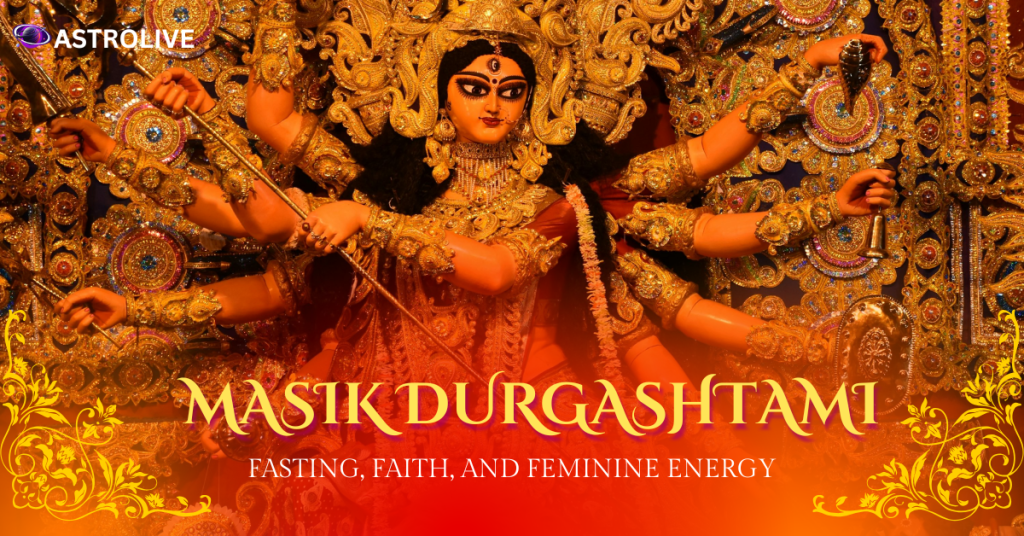India is a land of rich traditions and spiritual rituals. Among these sacred observances, Masik Durgashtami holds a special place in the hearts of devotees who seek blessings from Goddess Durga, the epitome of strength, courage, and divine energy.
Observed every month during the Ashtami tithi of the Shukla Paksha, this occasion brings devotees together to honor the feminine force that drives the universe. Whether you fast on this day, perform special puja, or simply seek blessings for peace and prosperity, this monthly celebration offers deep spiritual significance.
How Often Does It Fall In A Month And Why?
This day is celebrated once every month on the eighth day (Ashtami) of the waxing moon phase, also known as Shukla Paksha. As per the Hindu lunar calendar, each month is divided into two parts, Shukla Paksha (the bright fortnight) and Krishna Paksha (the dark fortnight).
The Ashtami tithi of the Shukla Paksha is considered highly auspicious for worshipping Goddess Durga. Therefore, devotees observe this ritual every month without fail, leading to twelve celebrations in a year.
Unlike Navratri, which comes twice a year and involves grand-scale celebrations, Masik Durgashtami is a quieter, personal affair marked by devotion, fasting, and prayer. Yet, the energy and power this day carries are no less profound.
Check Auspicious Timings With Today’s Panchang
Types Of Masik Durgashtami
Although the ritual is similar every month, it is often observed differently based on the month and region:
- Chaitra Durgashtami – Closely aligned with Chaitra Navratri, observed with greater devotion.
- Ashwin Durgashtami – This is celebrated around the time of Sharad Navratri.
- Margashirsha Durgashtami – Popular in Maharashtra, where it is celebrated with fasting and temple visits.
- Magh And Falgun Durgashtami – Important for tantra practitioners and devotees seeking spiritual awakening.
Each month, the form of Durga worshipped may vary. For example, some devotees may worship Kali in one month and Mahagauri in another, depending on the lunar alignment and regional traditions.
Don’t miss this: When Does Ashada Masam 2025 Begin & Why Is It Unique?
History Of This Festival
The roots of Masik Durgashtami can be traced back to ancient Hindu scriptures and Puranic texts. According to mythology, the day marks the defeat of the demon Mahishasura by Goddess Durga. She emerged from the combined energies of all the gods to defeat evil, and her victory is celebrated during both Navratri and the monthly Durgashtami.
In the Devi Bhagavatam, Goddess Durga is praised as the divine force that upholds cosmic balance. She is the Shakti (energy) that supports creation, sustains life, and destroys evil. Worshipping her monthly strengthens spiritual resolve and invites divine blessings.
Many believe that observing this sacred vrat helps in cleansing negative karma, removing fear, and empowering oneself with divine energy.
Masik Durgashtami Vrath Katha
The Vrath Katha narrates the story of a poor Brahmin woman named Sumati, who was suffering from poverty, illness, and marital distress. Guided by a sage, she started observing the this vrat with full devotion.
In time, her life transformed, her husband found stable work, her health improved, and her family life flourished. It is believed that Goddess Durga, pleased with Sumati’s dedication, blessed her with peace and prosperity.
This story illustrates the power of sincere devotion. The vrat not only improves material conditions but also brings spiritual clarity.
Masik Durgashtami Rules Of Fasting
Fasting during this day is not merely about abstaining from food; it’s a spiritual discipline aimed at purifying the mind and body. Here are some key rules to follow:
- Start the fast from sunrise and end after the evening puja.
- Avoid grains, salt, and processed foods.
- Consume only fruits, milk, and sattvic food items.
- Chant Durga mantras and read the Durgashtami Vrath Katha.
- Stay away from arguments, anger, or gossip.
- Keep the house clean and avoid consumption of meat or alcohol.
Some devotees choose to observe a complete nirjala fast (without food and water), while others opt for a partial fast depending on their health.
Also Read : Devshayani Ekadashi 2025: Date, Spiritual Significance, Story & Rituals
Masik Durgashtami Puja Vidhi
The puja on this day is simple yet spiritually uplifting. Here’s a step-by-step guide to performing the ritual at home:
1. Early Morning Ritual
- Wake up before sunrise.
- Take a bath and wear clean, traditional clothes.
- Clean your puja room or altar.
2. Setting Up The Altar
- Place an idol or picture of Goddess Durga.
- Decorate with flowers, diyas, and kumkum.
- Keep offerings like fruits, sweets, and coconut ready.
3. Chanting And Aarti
- Begin with lighting a diya.
- Offer kumkum, flowers, and fruits to the goddess.
- Chant “Om Dum Durgayei Namaha” 108 times or recite Durga Saptashati verses.
- Perform Durga aarti with full devotion.
4. Offer Prayers For Specific Blessings
- Ask for protection, strength, health, or family happiness.
- Conclude the puja by distributing prasad among family members.
This ritual, though brief, helps in connecting with the divine mother and revitalizing your spiritual energy.
Astrology Benefits Of This Vrath
Astrologers believe that observing this vrat brings planetary alignment and energetic balance. Here are some powerful benefits:
- Neutralizes the malefic effects of Rahu and Ketu.
- Improves the strength of the Moon in one’s horoscope, bringing emotional stability.
- Strengthens the 5th and 9th houses related to luck and intellect.
- Helps overcome delays in marriage and career setbacks.
- Encourages inner courage and willpower during tough times.
Those undergoing Saturn’s sade-sati or facing obstacles in life can particularly benefit from regular observance of this vrat.
Remedies For Marital Bliss And Luck
Goddess Durga is often worshipped for resolving issues related to marriage and relationships. On this auspicious day, you can perform special remedies to attract harmony:
- Offer red flowers and sindoor to Goddess Durga for a happy married life.
- Unmarried women can observe this fast to find a compatible life partner.
- Couples facing disputes should chant “Durga Ashtottara Shatanamavali” together.
- Lighting a ghee diya facing north-east helps increase positivity at home.
- Offering a red chunari (veil) to the Goddess enhances feminine energy and fertility.
Those seeking luck in legal matters, career growth, or family peace should regularly observe this sacred day.

Shukla Paksha Ashtami: Its Connection To Masik Durgashtami
One of the most frequently asked questions is: Shukla Paksha Ashtami Kab Hai? The answer varies each month, depending on the Hindu lunar calendar. This tithi, which falls on the eighth day of the Shukla Paksha (the waxing phase of the moon), holds spiritual importance across various Hindu rituals. To know the exact date, devotees must refer to a reliable Panchang (Hindu almanac) every month.
The connection between Shukla Paksha Ashtami and the monthly observance dedicated to Goddess Durga is deeply rooted in tradition. While Shukla Ashtami simply refers to the lunar day, it takes the form of Masik Durgashtami when specifically devoted to Durga’s worship. This transformation elevates the day from a regular lunar phase to a sacred occasion filled with spiritual energy.
In essence, every Shukla Ashtami holds spiritual significance, but not all are celebrated as Durgashtami unless dedicated to Devi Durga. This distinction helps devotees understand why this day is marked with such devotion every month.
Final Thoughts
In a world filled with chaos and stress, Masik Durgashtami offers a sacred pause, an opportunity to reconnect with your inner power and the divine feminine energy of the universe. Through fasting, puja, and devotion, you not only honor the goddess but also empower your soul.
Whether you’re new to spiritual practices or a lifelong devotee, this monthly vrat invites you to embrace courage, protection, and transformation. Mark your calendars, follow the rituals with sincerity, and let it become a regular spiritual celebration in your life.







